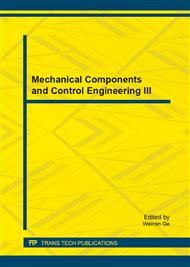p.1064
p.1068
p.1072
p.1076
p.1081
p.1086
p.1090
p.1094
p.1098
Modal Parameters Identification of Time-Varying System Based on Hilbert-Huang Transform
Abstract:
Mass distribution of floating structures will change due to such factors as ballast water management during ship sailing or inward and outward port, crane movement during construction, and the loading and unloading of cargoes on the offshore platform structures, which will then make its natural frequency change with time. While traditional modal identification cannot deal with the issues of non-stationary of time-varying system, Hilbert-Huang transform is quite effective for the processing and analysis of non-stationary signal. Therefore, this paper investigates the identification of linear time-varying system using the Hilbert-Huang transform, and conducts a numerical simulation of the two degrees-of-freedom time-varying system. In addition, this paper designs a cantilever beam subjected to a moving mass, and then makes a comparison of the identification results between the present identification method and those from finite element method (FEM) and eigensystem realization algorithm (ERA), which shows a higher accuracy of the present method for modal identification of time-varying system.
Info:
Periodical:
Pages:
1081-1085
Citation:
Online since:
October 2014
Authors:
Price:
Сopyright:
© 2014 Trans Tech Publications Ltd. All Rights Reserved
Share:
Citation:


